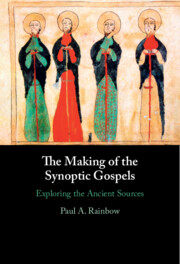Book contents
- The Making of the Synoptic Gospels
- The Making of the Synoptic Gospels
- Copyright page
- Contents
- Preface
- Abbreviations and Symbols
- Note on Color Tables
- 1 Introduction
- 2 State of the Question
- 3 Testimonies of Galilee: Q
- 4 Testimony of the Leaders at Jerusalem
- 5 Embryonic Mark and Matthew
- 6 Luke’s Preparation
- 7 Luke
- 8 Mark
- 9 Matthew (Greek)
- 10 Independence
- Appendixes
- Bibliography
- Indexes
5 - Embryonic Mark and Matthew
Published online by Cambridge University Press: 21 November 2024
- The Making of the Synoptic Gospels
- The Making of the Synoptic Gospels
- Copyright page
- Contents
- Preface
- Abbreviations and Symbols
- Note on Color Tables
- 1 Introduction
- 2 State of the Question
- 3 Testimonies of Galilee: Q
- 4 Testimony of the Leaders at Jerusalem
- 5 Embryonic Mark and Matthew
- 6 Luke’s Preparation
- 7 Luke
- 8 Mark
- 9 Matthew (Greek)
- 10 Independence
- Appendixes
- Bibliography
- Indexes
Summary
Eusebius preserved valuable traditions of Papias going back to St. John concerning the origins of the gospels of Mark and of Matthew. Before writing the Greek gospels we have, between AD 42 and 46, Mark made an unordered notebook of Peter’s memoirs about Jesus, and Matthew arranged Jesus’s words and deeds into an integrated narrative in Hebrew. These drafts were for private circulation among close acquaintances and were never published. Matthew’s could have served as a memory prop for the apostles’ oral deliveries in missionary situations. It probably informed the triple tradition behind the synoptic gospels.
- Type
- Chapter
- Information
- The Making of the Synoptic GospelsExploring the Ancient Sources, pp. 115 - 146Publisher: Cambridge University PressPrint publication year: 2024

